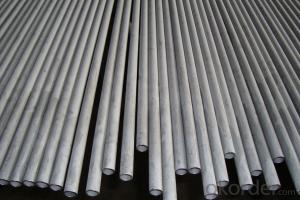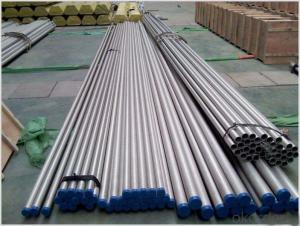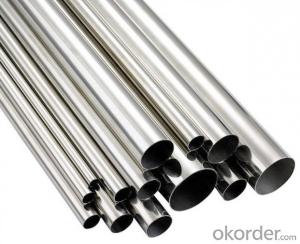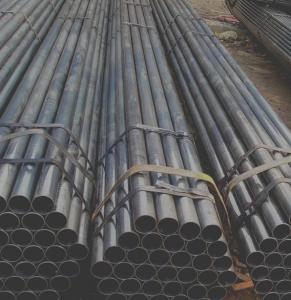Boiler Heat Exchange Stainless Steel Pipe 31803 ASTM A213
- Loading Port:
- Ningbo
- Payment Terms:
- TT OR LC
- Min Order Qty:
- 1 m.t.
- Supply Capability:
- 5000 m.t./month
OKorder Service Pledge
OKorder Financial Service
You Might Also Like
1、Structure of Boiler Heat Exchange Stainless Steel Pipe 31803 ASTM A213 Description:
Boiler Heat Exchange stainless steel pipe is often used in the heating system. Heating system, or those stored energy (such as solar energy) in the form of heat, need to be built with the material that can withstand temperatures up to 550 degrees Celsius. High chromium molybdenum welded steel pipe can work in the extreme, which maintain as the ideal material for the construction of power station.
2、Main Features of Boiler Heat Exchange Stainless Steel Pipe 31803 ASTM A213:
• High manufacturing accuracy
• High strength
• Small inertia resistance
• Strong heat dissipation ability
• Good visual effect
•Reasonable price
3、Boiler Heat Exchange Stainless Steel Pipe 31803 ASTM A213 Images:
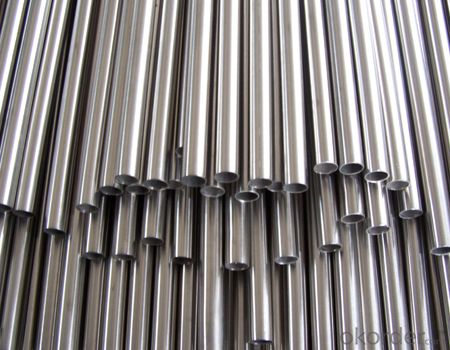
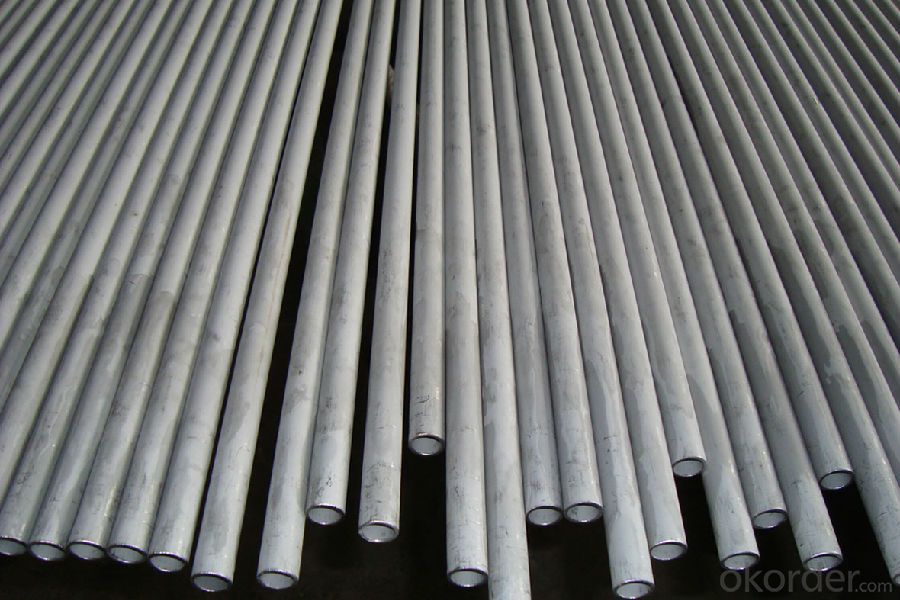
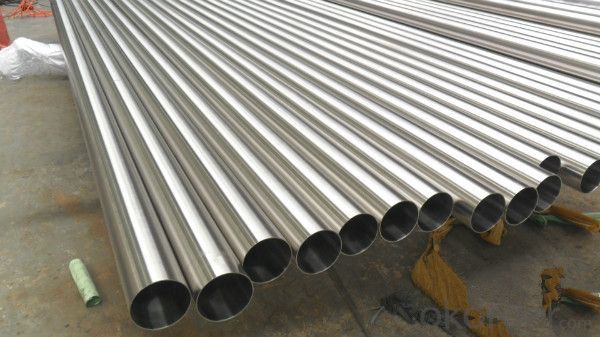
4、Boiler Heat Exchange Stainless Steel Pipe 31803 ASTM A213 Specification:
1)Commodity: heat exchanger pipe
2))Material: 304,316L,304L,316,321,310S,etc
3)Thickness:0.5-100mm
4)Length: 1-14m
| Material Grade | 304,304L,316 ,316L,321,310S,2205,904and so on. |
| Standard | ASTM A312, A554, A249, A269 and A270,ect |
| DIN 17456-85 , DIN 17458-85, DIN 17459-92,ect | |
| JIS G3446-1994, JIS G3448-1997, JIS G3459-1997, JIS G3463-1994,ect | |
| GB13296-1991, GB14975-2002, GB14976-2002,ect | |
| Outer Diameter | 13.7-2020mm |
| Thickness | 0.5-50mm |
| Length | 1m -12m or as customers' request |
| Polish | 180G, 320G, 400G Satin / Hairline |
| 400G, 500G, 600G or 800G Mirror finish | |
| Test | eddy current inspection, ultrasonic inspection, X-ray inspection, real-time imaging, hydrostatic test, spectral analysis, intergranular corrosion, water pressure test, and mechanical property testing facilities. |
| Payment | 1) by L/C at sight, |
| 2) 30% deposit, 70% balance before Shipping. | |
| Delivery time | A.7 days if this goods is stock goods. |
| B.25 days if this goods will be produced after order | |
| Validity | Valid time is 3 days for price usually. |
| Payment terms | FOB QINGDAO |
| MOQ | 1 ton |
| Capacity | 1000 ton per month |
| Certificate | ISO, SGS, and third part inspection |
| Applications | the products are widely used in chemical industry, condenser pipe, heat exchanger, petroleum, shipping military, environment protection, high temperature resistant, low temperature resistant, corrosion resistant and so on. |
| packing details | 1) Wooden-box Package. 2) The Wooden Frame Packing. 3) Intertexture Cloth Packaging with the Iron Sheet Bonding and the Two Terminals Covered With Plastic Dome. |
5、FAQ of Boiler Heat Exchange Stainless Steel Pipe 31803 ASTM A213:
①How is the quality of your products?
Our products are manufactured strictly according to national and internaional standard, and we take a test on every pipe before delivered out. If you want see our quality certifications and all kinds of testing report, please just ask us for it.
Guaranteed: If products’ quality don’t accord to discription as we give or the promise before you place order, we promise 100% refund.
②How about price?
Yes, we are factory and be able to give you lowest price below market one, and we have a policy that “ for saving time and absolutely honest business attitude, we quote as lowest as possible for any customer, and discount can be given according to quantity”,if you like bargain and factory price is not low enough as you think, just don’t waste your time.Please trust the quotation we would give you, it is professional one.
③Why should you chose us?
Chose happens because of quality, then price, We can give you both.Additionally, we can also offer professional products inquiry, products knowledge train(for agents), smooth goods delivery, exellent customer solution proposals.Our service formula: good quality+good price+good service=customer’s trust
SGS test is available, customer inspection before shipping is welcome, third party inspection is no problem.
Any question, pls feel free to contact us !
- Q: What are the disadvantages of using stainless steel pipes?
- Some potential disadvantages of using stainless steel pipes include their higher cost compared to other materials, their susceptibility to corrosion under certain conditions, and the difficulty of welding and shaping them. Additionally, stainless steel pipes may be prone to scratching or denting, and they can be less resistant to certain chemicals or extreme temperatures compared to other materials.
- Q: What are the different types of stainless steel pipes available?
- There is a variety of stainless steel pipes to choose from, each with its own unique properties and uses. Firstly, we have the austenitic stainless steel pipes. These are highly versatile and commonly used due to their high chromium and nickel content, which provides excellent resistance against corrosion and oxidation. They find applications in construction, automotive, and food processing industries. Secondly, we have ferritic stainless steel pipes. These pipes have high levels of chromium and low levels of carbon, resulting in exceptional corrosion resistance. They are often utilized in situations where strength and resistance to stress corrosion cracking are crucial. Next, we have martensitic stainless steel pipes. These pipes are renowned for their strength and hardness. They are commonly found in applications that require resistance to wear and abrasion, such as cutlery, tools, and bearings. Moving on, we have duplex stainless steel pipes. These pipes combine the properties of austenitic and ferritic stainless steels, offering excellent corrosion resistance and high strength. They are frequently utilized in industries that demand resistance to chloride stress corrosion cracking, like offshore oil and gas production. Lastly, we have precipitation-hardening stainless steel pipes. These pipes are heat-treatable and possess both high strength and corrosion resistance. They are often employed in industries such as aerospace and chemical processing, where both strength and resistance to corrosion are essential. These examples illustrate the various options available in stainless steel pipes. The choice of the appropriate type depends on the specific application and the desired properties, including corrosion resistance, strength, and temperature resistance.
- Q: How do stainless steel pipes compare to PVC pipes?
- Stainless steel pipes and PVC pipes are both widely used in various industries and applications, but they have distinct differences that make them suitable for different purposes. One of the key differences is the material composition. Stainless steel pipes are made from an alloy of iron, chromium, and other elements, which provides excellent strength and corrosion resistance. On the other hand, PVC pipes are made from a synthetic plastic polymer known as polyvinyl chloride, which offers good chemical resistance but is not as strong as stainless steel. In terms of strength and durability, stainless steel pipes have the upper hand. They can withstand high pressure and are highly resistant to heat, making them ideal for applications that involve transporting hot liquids or gases. PVC pipes, although not as strong, are lightweight and flexible, which makes them easier to handle and install in certain applications. Another important aspect to consider is the cost. PVC pipes are generally more affordable than stainless steel pipes, making them a popular choice for residential plumbing and other low-pressure applications. Stainless steel pipes, being more expensive, are often used in industrial settings where their superior strength and corrosion resistance are necessary. When it comes to lifespan, stainless steel pipes have a longer life expectancy compared to PVC pipes. Stainless steel is highly resistant to corrosion, rust, and other chemical reactions, which allows it to maintain its structural integrity over a longer period of time. PVC pipes, while durable, can degrade over time due to exposure to UV light, extreme temperatures, and certain chemicals. In terms of environmental impact, PVC pipes have raised concerns over the years due to the production and disposal of PVC, which involves the release of toxic chemicals. Stainless steel pipes, on the other hand, are considered more environmentally friendly as they can be recycled and have a longer lifespan. In summary, stainless steel pipes and PVC pipes have their own unique characteristics and advantages. Stainless steel pipes excel in strength, durability, and corrosion resistance, making them suitable for high-pressure and high-temperature applications. PVC pipes, on the other hand, are lightweight, affordable, and easy to install, making them a popular choice for low-pressure applications. Ultimately, the choice between these two materials depends on the specific requirements and constraints of the project at hand.
- Q: How are stainless steel pipes joined together?
- Stainless steel pipes are joined together through various methods such as welding, threading, and compression fittings.
- Q: Can stainless steel pipes be pickled?
- Indeed, it is possible to pickle stainless steel pipes. Pickling serves as a method employed in order to eliminate impurities, including scale, rust, and various surface contaminants, from the exterior of stainless steel. This procedure entails submerging the stainless steel pipes in a pickling solution, which typically consists of a combination of nitric and hydrofluoric acid. As a result of the pickling solution's action, the impurities are dissolved, leaving behind a pristine and sleek surface on the stainless steel pipes. Pickling is widely utilized in industries such as oil and gas, food processing, and chemical processing to prepare stainless steel pipes for subsequent procedures or to enhance their resistance to corrosion.
- Q: What is the difference between stainless steel pipes and PVC pipes?
- Stainless steel pipes are made from a durable and corrosion-resistant material, while PVC pipes are made from a lightweight and cost-effective plastic. Stainless steel pipes are suitable for high-pressure and high-temperature applications, while PVC pipes are commonly used for water supply and drainage systems. Additionally, stainless steel pipes have a longer lifespan and can withstand harsh environmental conditions, whereas PVC pipes may degrade over time and are more prone to cracking or breaking.
- Q: What is the maximum allowable working pressure for stainless steel pipes?
- The maximum allowable working pressure for stainless steel pipes depends on several factors, including the grade of stainless steel, the pipe size, and the temperature at which the pipe will be operating. Generally, stainless steel pipes have higher pressure ratings compared to other materials due to their excellent corrosion resistance. The maximum allowable working pressure (MAWP) is typically determined by standards and codes such as the American Society of Mechanical Engineers (ASME) B31.3 and B31.1 codes. These codes provide guidelines for the design, fabrication, and installation of piping systems. For example, ASME B31.3 provides tables and formulas to calculate the maximum allowable working pressure based on the temperature, wall thickness, and material properties of the stainless steel pipe. The code also considers factors such as safety factors, corrosion allowances, and the intended service conditions. It is important to consult the specific standards and codes applicable to the stainless steel pipe being used to determine its maximum allowable working pressure. Working pressures can vary significantly depending on the pipe grade, dimensions, and intended application.
- Q: How do stainless steel pipes compare to cast iron pipes?
- There are two popular options for plumbing systems: stainless steel pipes and cast iron pipes. However, these two choices have notable differences when it comes to durability, cost, and corrosion resistance. To begin with, stainless steel pipes are widely recognized for their exceptional durability. They possess a higher strength-to-weight ratio and are less susceptible to cracking or breaking in comparison to cast iron pipes. Consequently, stainless steel pipes are well-suited for high-pressure scenarios or areas with heavy traffic. On the contrary, cast iron pipes have traditionally been acknowledged for their strength and longevity. They exhibit a remarkable resistance to impact and vibrations, which makes them ideal for locations where durability is of utmost importance, such as underground or in commercial buildings. Nevertheless, cast iron pipes are more prone to cracking or corrosion over time, particularly in acidic or alkaline environments. In terms of costs, stainless steel pipes generally require a higher upfront investment in contrast to cast iron pipes. Nonetheless, stainless steel pipes boast a longer lifespan and demand minimal maintenance, ultimately resulting in cost savings in the long term. Conversely, cast iron pipes may entail lower initial expenses but may involve more frequent maintenance and repairs, consequently escalating the overall costs over time. Regarding corrosion resistance, stainless steel pipes surpass cast iron pipes. Stainless steel contains a substantial amount of chromium, which forms a protective oxide layer that prevents corrosion. This characteristic renders stainless steel pipes highly resistant to rust, chemicals, and extreme temperatures. Conversely, cast iron pipes are more prone to rust and corrosion, especially if not adequately coated or maintained. In summary, stainless steel pipes offer superior durability, corrosion resistance, and long-term cost savings compared to cast iron pipes. Although cast iron pipes possess their own advantages, such as strength and impact resistance, stainless steel pipes emerge as a more reliable and versatile option for various plumbing applications.
- Q: What is the maximum diameter for a stainless steel pipe?
- The maximum diameter for a stainless steel pipe can vary depending on various factors such as the manufacturing process, grade of stainless steel, and intended application. However, in general, stainless steel pipes can be manufactured in a wide range of diameters to suit various industrial and commercial needs. The maximum diameter can range from a few millimeters for small, precision pipes used in industries like medical and instrumentation, to several meters for large-diameter pipes used in applications such as oil and gas pipelines or industrial infrastructure. It is recommended to consult with a reputable manufacturer or supplier to determine the specific maximum diameter available for the desired stainless steel pipe.
- Q: How do you calculate the weight of stainless steel pipes?
- To calculate the weight of stainless steel pipes, you need to consider a few factors. Firstly, you need to determine the outer diameter (OD) and the thickness (T) of the pipe. Once you have these measurements, you can use the following formula to calculate the weight per foot (or meter) of the stainless steel pipe: Weight per foot (or meter) = (OD - T) * T * 0.0246615 This formula assumes that the stainless steel pipe is of a round shape. The weight per foot can then be multiplied by the length of the pipe in feet (or meters) to calculate the total weight. It is important to note that the density of stainless steel may vary depending on the specific grade and composition. Therefore, the weight calculated using this formula will provide an approximate value. If precise weight calculations are required, it is recommended to consult a reference table or contact the manufacturer for more accurate information.
Send your message to us
Boiler Heat Exchange Stainless Steel Pipe 31803 ASTM A213
- Loading Port:
- Ningbo
- Payment Terms:
- TT OR LC
- Min Order Qty:
- 1 m.t.
- Supply Capability:
- 5000 m.t./month
OKorder Service Pledge
OKorder Financial Service
Similar products
Hot products
Hot Searches
Related keywords

